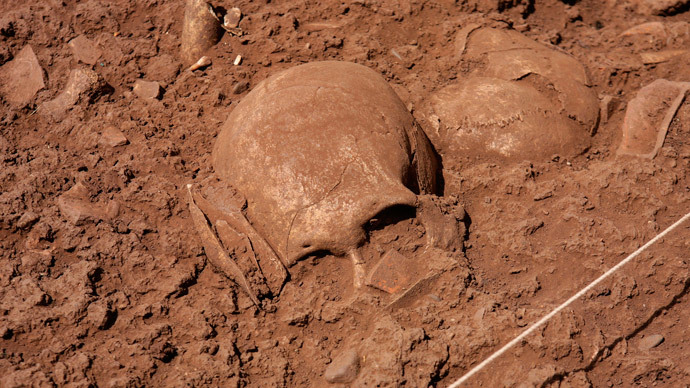Blast from the past: Ancient skull suggests Neanderthals and Homo sapiens interbred

A partial skull unearthed in the Manot Cave in Israel's West Galilee has given paleontologists the first key evidence that modern humans co-inhabited the area with Neanderthals with whom they possibly interbred up to 55,000 years ago.
Tel Aviv University anthropologist Israel Hershkovitz led the study published in the US journal Nature, hailed the ancient skull as "an important piece of the puzzle of the big story of human evolution."
The partial cranium, covered in a patina of minerals produced by the wet conditions within the cave, has allowed researchers from the Geological Survey of Israel to determine that the skull was between 50,000 to 60,000 years old.
"It is the first direct fossil evidence that modern humans and Neanderthals inhabited the same area at the same time," said paleontologist Bruce Latimer of Case Western Reserve University in Cleveland, who took part in the research.
Manot Cave in Israël, where a 55,000-year-old skull sheds new light on human migration patterns.( A Frumkin) pic.twitter.com/YLBQvubkPH
— rougier (@laurencerougie5) January 28, 2015
According to Latimer, the skull consisted of a rather small brain of around 1,100 milliliters, while the modern human brain averages around 1,400 milliliters. The fossil's gender is nonetheless unclear because it's missing the brow ridge, one marker for gender differences. Because the skull is from an adult, researchers said it wasn't related to other sub-adult human teeth and bones also found in the cave.
55,000-yr-old skull fragment may belong to human group that interbred with Neanderthals http://t.co/Qaijwy5tXnpic.twitter.com/1WIq67Mcbl
— Nature News&Comment (@NatureNews) January 29, 2015
"This leads us to believe that there are likely more fossils in the cave where other bones associated with the skull might be found," Mark Hans, chair of Cleveland's Case Western Reserve University's Department of Orthodontics said.
READ MORE: 13,000 yo skeleton sheds light on Native American origins
According to scientists, our species first appeared in Africa, about 200,000 years ago, and later migrated elsewhere. Neanderthals, meanwhile, prospered across Europe and Asia from about 350,000 to 40,000 years ago, going extinct after the arrival of Homo sapiens. It has been previously suspected that modern humans and Neanderthals were somewhere "in the same place at the same time,” but scientists lacked the physical evidence. The latest discovery challenges a previous premise that the two species could have come together somewhere in Europe, about 45,000 years ago.
"Modern humans and Neanderthals likely encountered each other foraging for food," Latimer said.
The prehistoric Manot cave is located in the region where Neanderthals periodically lived, along the only land route for ancient humans to take from Africa into the Middle East, Asia and Europe.
The fossil skull was discovered by accident by caver who in 2008 had rappelled through a newly opened roof of the previously unknown cave that had been sealed for 30,000 years. Hunting tools and animal bones have been excavated from the cave, along with human remains.












